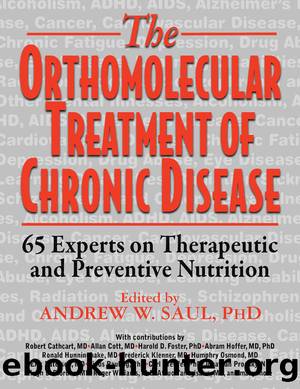Orthomolecular Treatment of Chronic Disease: 65 Experts on Therapeutic and Preventive Nutrition by Andrew W. Saul PH.D

Author:Andrew W. Saul PH.D. [Saul PH.D., Andrew W.]
Language: eng
Format: azw3, epub
Publisher: Turner Publishing Company
Published: 2014-05-31T16:00:00+00:00
Excerpted from the Orthomolecular Medicine News Service, March 23, 2005.
TREATMENT OF HYPERTENSION FROM AN ORTHOMOLECULAR MEDICINE STANDPOINT
by George D. O’Clock, PhD
High blood pressure (hypertension) is the most prevalent cardiovascular disease. Approximately 30 million Americans have been diagnosed with hypertension1 and over 58 million Americans appear to be affected.2 Within certain segments of the medical profession, blood pressure thresholds and definitions for hypertension vary. Often, a blood pressure reading between 140 and 160 systolic (upper number) and/or between 90 and 95 diastolic (lower number) is used as a “borderline” to identify the transition from an acceptable blood pressure level into the realms of hypertension.3 Absolute hypertension occurs, once the 160/95 millimeters of mercury (mmHg) limits have been exceeded.2
The majority of people with hypertension have essential hypertension. In their case, the high blood pressure condition does not have an obvious cause.3,4 Cardiac rate and cardiac output increase in some individuals with hypertension, but not all. However, an increase in total vascular peripheral resistance (pressure against the walls of the blood vessels) is a common characteristic of hypertension.
Experimental Procedure
Systolic/diastolic blood pressure and pulse rate were obtained for a number of individuals over a three-year period. One of the individuals was a 58-year-old male diagnosed with essential hypertension. Initially, his average systolic/diastolic blood pressure was approximately 176/104 mmHg with episodes exceeding 210/118 mmHg during periods of stress. Peak-to-peak systolic/diastolic blood pressure variations throughout the day of 60/18 mmHg were fairly common. An echocardiogram revealed hypertrophy (thickening) of the left ventricle. Records indicate that this person had an untreated high blood pressure problem for almost 16 years.
After recording blood pressure data for nine months, this individual accepted medication for his condition. Initially, this involved his taking a 5-milligram (mg) dose per day of the angiotensinconverting-enzyme (ACE) inhibitor enalapril (Vasotec). After taking the Vasotec prescription for eight days, his average blood pressure dropped to approximately 152/90 mmHg with peak-to-peak variations decreasing to 30/10 mmHg. Although further intervention was discussed, the hypertense individual would not accept an increase in ACE-inhibitor dosage and would not accept any other form of medication (such as beta blockers, calcium channel blockers, or diuretics). He preferred to try other means of blood pressure reduction through diet, stress control, exercise, and nutritional supplementation. There is some controversy concerning blood pressure variability and the impact of various kinds of activities and stress on blood pressure data. Part of this three-year study involved recording blood pressure variations that can occur with stress (family and work-related), diet, exercise, leisure-time activities, relaxation, and sexual activity for an individual who has hypertension.
From an orthomolecular medicine standpoint, the effect of various nutritional supplements (vitamins, minerals, soy products, herbs, etc.) on blood pressure and blood pressure variations is of significant interest. One very interesting feature concerning the various methods that lower blood pressure involves their combined (cumulative) effect. Information on the ability of the various methods to lower blood pressure in a coherent additive manner, or a noncoherent additive manner, is very important from a treatment expectations standpoint.
Mechanisms of Hypertension
One
Download
Orthomolecular Treatment of Chronic Disease: 65 Experts on Therapeutic and Preventive Nutrition by Andrew W. Saul PH.D.epub
This site does not store any files on its server. We only index and link to content provided by other sites. Please contact the content providers to delete copyright contents if any and email us, we'll remove relevant links or contents immediately.
Periodization Training for Sports by Tudor Bompa(8170)
Why We Sleep: Unlocking the Power of Sleep and Dreams by Matthew Walker(6618)
Paper Towns by Green John(5091)
The Immortal Life of Henrietta Lacks by Rebecca Skloot(4525)
The Sports Rules Book by Human Kinetics(4294)
Dynamic Alignment Through Imagery by Eric Franklin(4118)
ACSM's Complete Guide to Fitness & Health by ACSM(3989)
Kaplan MCAT Organic Chemistry Review: Created for MCAT 2015 (Kaplan Test Prep) by Kaplan(3940)
Introduction to Kinesiology by Shirl J. Hoffman(3726)
Livewired by David Eagleman(3684)
The Death of the Heart by Elizabeth Bowen(3552)
The River of Consciousness by Oliver Sacks(3541)
Alchemy and Alchemists by C. J. S. Thompson(3451)
Bad Pharma by Ben Goldacre(3357)
Descartes' Error by Antonio Damasio(3230)
The Emperor of All Maladies: A Biography of Cancer by Siddhartha Mukherjee(3066)
The Gene: An Intimate History by Siddhartha Mukherjee(3047)
The Fate of Rome: Climate, Disease, and the End of an Empire (The Princeton History of the Ancient World) by Kyle Harper(3003)
Kaplan MCAT Behavioral Sciences Review: Created for MCAT 2015 (Kaplan Test Prep) by Kaplan(2940)
